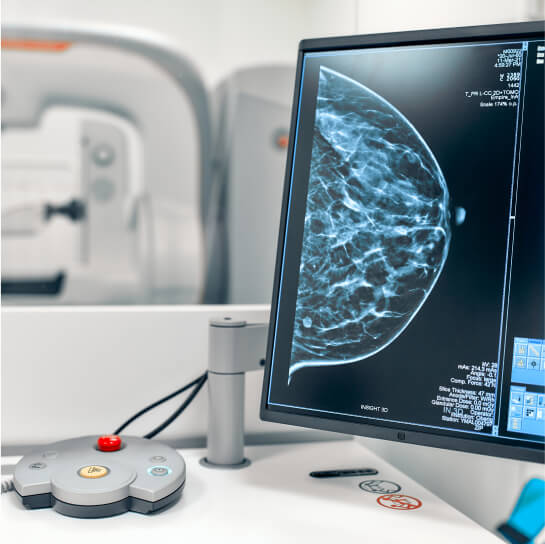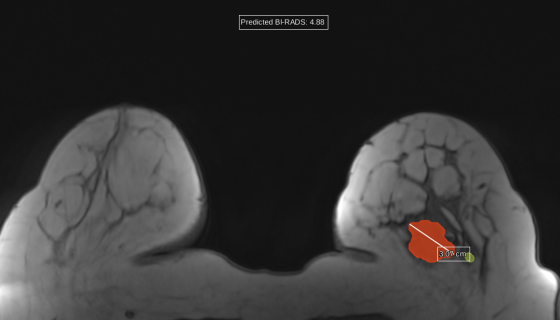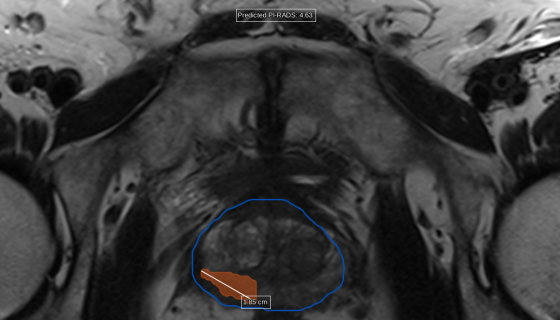RAIDAS
Revolutionizing MRI Diagnostics for Breast and Prostate Cancer with AI
RAIDAS is a state-of-the-art machine learning-based diagnostic assistance system designed to enhance the accuracy and efficiency of MRI evaluations. It integrates into existing diagnostic workflows, providing radiologists with invaluable support in identifying potential lesions in breast and prostate MRI scans.
RAIDAS – addressing key challenges in cancer detection
RAIDAS enhances early detection of breast and prostate cancer through advanced MRI analysis.
The system automatically classifies MRI scans using BI-RADS scores for breast tissue and PI-RADS scores for prostate tissue, providing radiologists with valuable assistance in distinguishing between benign and malignant findings.
By providing a second result RAIDAS reduces radiologists’ workload, allowing them to be more confident in their diagnosis.

AI MRI classification
RAIDAS leverages AI trained on manually classified MRI time series to determine BI-RADS/PI-RADS values. This ensures high precision in diagnosing and classifying MRI scans as benign or malignant.
3D Data Analysis
Our system tackles the complexities of 3D MRI data, utilizing special preprocessing steps such as pre-segmentation and data augmentation to handle larger data volumes and adapt network structures for optimal performance.
Explainable AI
RAIDAS employs explainable AI methods to pinpoint relevant areas in MRI data, providing clear insights into the regions that most significantly impact the classification results. This transparency helps radiologists to make more informed decisions.
Seamless Integration
RAIDAS integrates effortlessly with existing PACS servers, allowing radiologists to access results in real time without disrupting their workflow.
Enhanced Diagnostic Confidence
The report generated by RAIDAS leverages advanced AI prediction results to provide detailed insights into MRI images. While the AI’s computed data and visualizations offer significant assistance in identifying clinically relevant features, they are designed to complement, not replace, the expert diagnosis of medical professionals.

Visualization of Potential Lesions in the Breast

Visualization of Potential Lesions in the Prostate
Supportive and unobtrusive
RAIDAS’s integration into clinical practice involves a straightforward workflow where the radiologist first examines the MRI series using traditional methods. They then compare their findings with AI-generated results to verify or refine their diagnosis. This process ensures that radiologists are not influenced by AI in their initial assessment but have access to AI’s insights for confirmation.
Step 1 - unbiased expert diagnosis
The radiologist first examines the MRI series of a patient visually using the usual method at their diagnostic console. They classify the MRI images into BI-RADS/PI-RADS categories based on their expertise.
Step 2 - compare with the AI report
The radiologist compares their results with those of the RAIDAS system. Additionally, they can see which areas in the MRI data contributed most significantly to the determination of the automatic BI-RADS/PI-RADS value.
Step 3 - expert decision
The radiologist then decides, based on the comparison and the highlighted areas in the MRI data, whether their manually determined diagnosis is accurate or if the AI data necessitates further refinement or correction of the diagnosis.
Step 4 - the RAIDAS system learns
The radiologist's decision is fed back into the RAIDAS system, contributing to its improvement in future versions.
This approach offers several advantages:
FAQs
RAIDAS operates seamlessly within the radiologist’s existing environment, without requiring additional software. After the radiologist completes their analysis, they can consult RAIDAS’s AI-generated insights to confirm their findings or identify any missed anomalies.
RAIDAS is an AI-powered diagnostic assistance system designed to support radiologists in analyzing breast and prostate MRI scans. It helps detect small anomalies, reducing the risk of oversight and enhancing diagnostic confidence.
To schedule a free demo appointment, you can request one through the A.I.gnostikum website.
As of now, RAIDAS focuses on assisting with breast and prostate MRI diagnostics.
Currently, RAIDAS is compatible exclusively with Siemens MRI imaging systems.
Schedule a software-demo appointment.
Contact us to schedule a free appointment!
